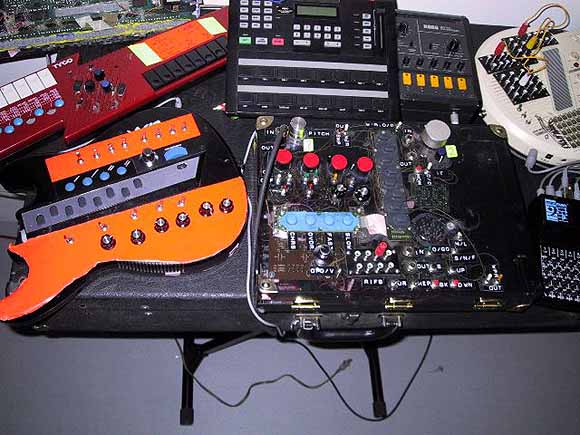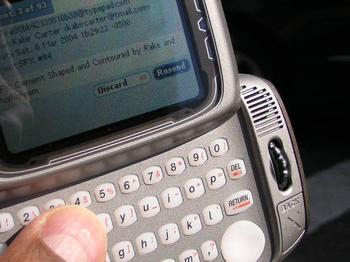
View current page
...more recent posts

As an example of the circuit bent gear phenomenon mentioned in the previous post--this is Nautical Almanac's equipment table.
Paul Slocum is doing some interesting work in the emerging "circuit bent" field, where old games, toys, and keyboards get broken open and rewired to make new sounds. Check out his repurposed Epson dot matrix printer that makes music and still prints out images. This is fascinating on the level of Mad Maxian, Professor-making-a-nuclear-reactor-out-of-the-ship's-radio-and-coconuts bricolage (or as an illustration of the Gibsonian axiom "the street finds its own uses for things"), but the printer is only part of a larger gesamtkunstwerk, including Slocum's band Tree Wave (a duo with Lauren Gray), which is making some of the coolest music around. While the band uses the printer and other low-tech gear (1977 Atari 2600 game console, 1986 portable 286 PC, 1983 Commodore 64 computer) to make its music, it's not the annoying, tuneless gameboy stuff we've been hearing in the galleries lately but rather has been compared to guitar bands such as My Bloody Valentine and early Stereolab. This is because the computers use fuzz tones and other psychedelic guitar-like sounds as opposed to pure video game bleeps. "Sleep" is a simply amazing 3 minutes of music that updates the Krautrock formula of drones-over-insistent-beats with rich, jangly, unmistakably consumer-electronic textures that just seem to keep surfacing in the mix. Catchy, crunchy rhythms kick away underneath while spare but sublime femme vocals float in over the top. The equipment making these sounds runs with custom music software written by Slocum for the band, obviously with a very analog-sounding end product in mind. According to the website there is also a video element used in live performance. Hopefully we'll get to see and hear all this here in NY soon.
Paul Slocum emailed to say he appreciated the above post on his work but perhaps isn't so happy to be slapped into the "circuit bending" category:
Is my work really circuit bending? key differences: (1) that traditional circuit bending has more of a chaotic element to it (placing wires without knowing exactly what's going to happen) where my stuff is mostly deliberate and calculated. And (2) while traditional circuit bending doesn't require much technical expertise, my work requires a ridiculous amount of geeky programming knowledge. (3) That my work really falls into the realm of software modification much more than hardware modification. All of my devices can easily be returned to their original state either by removing a cartridge or EPROM. Not so of circuit bend items. My stuff's like "Circuit Folding" or something.I described the genre as "emerging" but Ghazala says in the interview linked above that he started using found consumer electronics to make sound in the '60s. But the "instruments as sculpture" aspect of the trend perhaps isn't so interesting. Nautical Almanac's machines intrigue because they look like form following function, whether that's actually true or not. (Genuine bricolage as opposed to self-consciously arty bricolage--though the guitar body is pushing it.) Similarly, just because one rewired a consumer device doesn't make the sound interesting. Again, I liked NA the times I heard them as much for the mic-swallowing, pushing-the-limit intensity of their live act--and complex, hybrid analog/digital sounds I didn't think I'd heard before--as the tweaking of instruments. The question here is whether circuit-bending is a big or well defined enough field to incorporate Slocum's light, software-based interventions into existing equipment and Cory Arcangel's hacked Nintendo cartridges. Maybe that is the evolution of the genre, rather than something completely different. Which is not to say I'm not guilty of indulging in a facile journalistic hook.
In your blog, you are usually pretty unforgiving of redundant art. Does circuit bending deserve a bit of a thrashing here? Reed Ghazala thoroughly explored the idea what, like 25 years ago? And wasn't Nam Jun Paik kind of a bender as well (long before that)? I love that bending is accessible to so many people, but in many cases the audio results are totally unlistenable. The process and concept is the interesting part, and that's been so explored. It seems like it's time for something beyond a confused Speak & Spell and croaking SK-1. I'm kinda torn about the whole thing.
A few more (nerdy) thoughts on circuit bending and whether rewriting software for old games, toys, appliances, etc. should be included in it. Paul Slocum got lumped into the discussion because he participated in the recent Bent festival in New York and his modified Epson printer--as opposed to say, the vintage computers he works with--seems more in the bending spirit of altering consumer devices we don't normally think of as music-producing. That piece I would call bent, perhaps software-wise as opposed to hardware-wise (Slocum proposes "circuit folding" but that's not as blunt or catchy as "circuit bending"). As for whether bending produces boring work, Slocum notes in the comments that "lot of those ['80s] toys and keyboards sound crazy and awesome whether they're modified or not." Good point; j, on the other hand, says:
Circuit bending makes useful audio material if you have a well 'bent' machine which when in the hands of an experienced bender is mostly calculated as well.I'm for extending "circuit bending" to include hacking, with educating our ears to hear the distinctions good but still optional. ("For additional credit, is this [insert sound here] mechanically bent, virtually bent [i.e., within the program], or hacker bent [i.e., made by rewriting the program]?") I have a slight stake in this, having made some visual work that could be called circuit bent, even though it involved neither programming nor working within a program nor even getting out the soldering gun. Any citations to The Wire or Electronic Musician or other places where this issue might have been discussed would be appreciated. Also, it'd be great to hear more from Paul about the "bends for the Fisher Price Pixelvision video camera" he mentions--haven't seen any work done with that machine in quite a while but what I saw was inspiring.
That said, circuit bent machines' random nature are also an asset. They can provide phrases of sounds that just could not be made up in one's head.
I do think the distinction made between circuit bending and folding is interesting but one is not necessarily better than the other.

I've been checking out a recent Rhizome proposal and related blogs by sound artist Kabir Carter, the fourth panelist in the upcoming blogging and the arts event. Carter's sound blogs (a term I'm using, not entirely accurate--more below) are linked to and described there as follows:
I say the term "sound blogs" isn't entirely accurate, because unlike, say, David F. Gallagher's photoblog, which also records urban details in a diaristic way, Carter's journals don't document sounds via regular posting of .mp3 files, but rather verbal descriptions of audial phenomena. Many of these short, pointed, often poetic statements enter the journals "moblog" style--as the artist notes above, he types them into a handheld device, on the spot, from the locations where they were heard. The entries resemble a foley artist's deadpan record of sound effects in a movie or TV storyboard. Many of the "sounds" are actually visual descriptions of sound-producing activities, followed by the word "(inaudible)."Effects
Effects is my first net project. Originally posted as a "stealth" LiveJournal blog, Effects purports to be a diaristic account of my life, but instead only offers dry accounts of sounds that I have heard, or imagine to have heard. While attempting to make LiveJournal friends who can track my accounts, I have periodically contributed to an ever growing catalog of acoustical accounts that never reveal much about me, but hopefully say many things about how I have experienced sound.
http://www.livejournal.com/~effects/Walking In The City
I am presently realizing Walking in the City, a project commissioned by Subtropics, a Miami based music festival. I moblog (in real time) written descriptions and accounts of acoustic occurences that I audit while walking around New York City. The project was launched during Subtropics' festival opening, where 4 hours of my updates from the city were projected live in an arts and performance space in Miami. Until early April, I will continue to intermittently add to the initial log.
SFX: Two Street Signs Affixed to Same Post Vibrating against One AnotherI'm reminded of the Kenneth Goldsmith piece where the artist transcribed every word he spoke for a week and hung the transcriptions in a gallery. Like Goldsmith's work we take it on faith the artist isn't making stuff up. But Carter's blogs aren't as obviously sequential: he's moving around the city, and readers often must rely on their own deductive faculties to tell how (or whether) the sounds relate to each other--especially in the subtropics blog, where there's no timestamp. A run of posts gives you a feeling of momentary total immersion in a cacophonous, slightly unhinged street scene, and then you're abruptly transported underground, into a subway environment that feels equally random but has its own characteristic sonic events. The sheer amount and complexity of detail paints a cumulative impression of the city not ultimately that dissimilar from Gallagher's far more "accurate" (as in verifiable) photographic record. Both conjure a teeming world beyond our normal mundane powers of observation.
SFX #234 SFX: Bell Struck
SFX #233 SFX: Two Small Dogs Barking in Unison
SFX #232 UNKNOWN PERSON: "Not my fault the watermelon tastes like..."
SFX #231 UNKNOWN PERSON: "Police officer, can you go to the end of the train? There's a guy with a bag and blue jeans."
SFX #230 SFX: Droplet Falling from Small Bent Conduit (Inaudible)
Reading Carter's blogs is highly recommended, although they would doubtless have a different kind of interest if you were one of those baffled LiveJournal Friends experiencing them in blog time--that is, following the posts as they appeared.